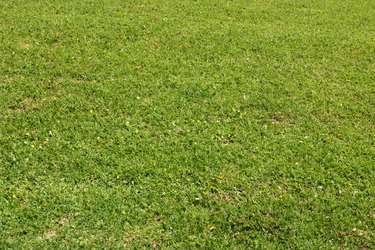
Homeowners often find a variety of little flies on their lawn grass. Sod webworms are common lawn grass pests that are small light gray, tan or white moths in their adult stage. Webworm larvae damage lawn grass, causing it to develop large areas of discoloration and a ragged appearance.
Identification
Video of the Day
Sod webworm larvae are damaging turfgrass pests. These caterpillars are usually beige, gray or green and remain hidden during the daytime by burrowing into the thick grass. Homeowners often see the adult form of sod webworms, which are little white, gray or tan moths that fly low over the grass when disturbed. According to the University of Arizona, sod webworm moths are often known as snout moths because they have forward projecting mouthparts. Sod webworm moths do not damage turfgrass; only the larvae cause damage to lawns.
Video of the Day
Effects
Sod webworm larvae feed mainly at night causing grass to develop a ragged appearance. Lawn grass often appears to have large patches of discolored grass, usually brown or yellow that increase in size as the larvae feed. Sob webworm moths hide in shrubs near lawn grass during the day and fly low over grass when the shrubs are disturbed. Female moths lay eggs on lawn grass, leaving clusters of up to 15 white eggs on grass blades, which hatch within seven days.
Cultural Control
Adult sod webworm moths are usually most noticeable during the summer months and the larvae causes damage to grass that is visible by the early part of fall. Adult moths are active from dusk until dawn and can be seen flying low over damaged grass. Provide your lawn grass with plenty of water to reduce drought stress and avoid mowing to low heights to minimize the damage from sod webworms. Avoid applying nitrogen-rich fertilizers to your grass, as this promotes rapid grass growth and increases the chances of sod webworm damage. A variety of beneficial insects feed on sod webworm larvae and their eggs, keeping their populations low. Ants, birds and parasitic wasps all feed on webworm larvae.
Chemical Control
Since the adult moths do not cause damage to lawn grass, control of sod webworms should be aimed at the larvae. Young larvae is most susceptible to insecticides and small larvae are easier to kill than larger larvae. Spot treatments may be effective if only a small portion of lawn grass is damaged. According to the University of Florida, IFAS Extension insecticides containing dimilin, spinosad or chlorantraniliprole may kill sod webworm larvae. Avoid spraying moths as they are not harmful and the insecticides may drift causing adverse effects in humans and animals in close proximity. If little moths are seen flying over your grass, assume they are laying eggs and the insecticides should be reapplied in seven to 10 days for best results.